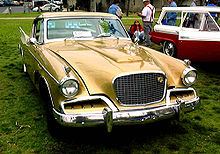Studebaker Golden Hawk
The Studebaker Golden Hawk was a 2-door hardtop coupé without B-pillars that was manufactured by the Studebaker Corporation in South Bend, Indiana from 1956 to 1958. It was the last Studebaker before the Avanti , whose styling was influenced by the well-known design office of Raymond Loewy . The Golden Hawk had the basic shape of the Champion and Commander Starliner models ; however, a large, almost vertical honeycomb grille was added, as well as a higher bonnet line in place of the earlier beveled nose, a higher trunk lid and tail fins.
This grille and raised bonnet were necessary to accommodate Packard's large 5.8-liter V8 with an output of 275 bhp (202 kW). This large, powerful machine in such a light car gave the Golden Hawk a phenomenal power-to-weight ratio for its time (with appropriate handling characteristics). Of all American production vehicles in 1956, the Golden Hawk had the second lowest power-to-weight ratio and only had to admit defeat to the Chrysler 300 B - and the more expensive Chrysler was after all a roadworthy sports car from the NASCAR series. Like the Chrysler 300 B, the Golden Hawk can be seen as the forerunner of the muscle cars of the 1960s. The heavy machine earned the car a reputation for being top heavy and difficult to drive, but contemporary tests prove otherwise. The Speed Age magazine tested the Golden Hawk in July 1956 against the Chrysler 300 B, the Ford Thunderbird and Chevrolet Corvette , and it was found that the Golden Hawk h the other km in acceleration from 0 to 100 / well outplayed in the times for the quarter mile. The magazine recorded the greatest acceleration at 7.9 sec. / 0–100 km / h and the top speed at over 200 km / h. Movie enthusiasts will recall a demonstration of these values by Charlie and Raymond Babitt ( Tom Cruise and Dustin Hoffman ) in the 1988 film Rain Man .
There was a wide range of colors (including two-tone paintwork, according to contemporary tastes). In the case of two-tone paintwork, the upper front part of the body, the roof and the rear end panel were initially painted in a contrasting color, the rest of the body in the basic color. From the end of 1956, the body above the belt line and the trunk lid were painted in a contrasting color, while the rear end panel, the roof and the body parts below the belt line were kept in the basic color.
An expanded list of surcharges and fewer basic equipment helped to keep prices low compared to last year's Studebaker President Speedster, which the Golden Hawk replaced. Even flashing lights were only available as special equipment.
The Golden Hawk came out with three other models of the Studebaker-Packard-Hawk series in 1956, all of which were developed from models of the regular Studebaker model range: the Flight Hawk - Coupé was a champion , the Power Hawk - Coupé was a Commander and the Sky Hawk - Hardtop was a President .
The Golden Hawk continued to be built in 1957 and 1958, but with a few changes. The Packard facility in Utica, Michigan , was leased to Curtiss-Wright in 1956 and then sold, putting an end to the production of the original Packards. Studebaker cars with the Packard logo continued to exist for two more years. The Packard V8 engine, which was introduced in 1955, was therefore no longer available and was replaced by the 4.7 liter "Small Bloc" V8 from Studebaker in conjunction with a McCulloch compressor , which - like the Packard engine - developed an output of 275 bhp (202 kW), but weighed 82 kg less. This improved handling and top speed of the car, making it the fastest Hawk until the GT Hawk with Avanti compressor appeared in 1963.
The styling also changed slightly. The bonnet got a GRP scoop and an opening in the bonnet underneath to make room for the compressor, which was mounted on the top front of the engine. The tail fins grew larger and were concave on the sides, painted in a contrasting color and topped with chrome strips. The Golden Hawk from 1958 had 14 "wheels instead of the previously usual 15", which lowered the car a little. There were no other changes.
The other models of the Hawk series were completely changed in 1957: the new Golden Hawk replaced its predecessor and the Sky Hawk, the new Silver Hawk was the successor to the 6-cylinder Flight Hawk and the 8-cylinder Power Hawk.
In the middle of the 1957 model year, a luxurious 400 model was introduced, which was blessed with leather upholstery, a carpeted trunk and special exterior appointments.
Like many other expensive cars, the Golden Hawk suffered from the recession of the late 1950s, and after just 878 sales in 1958, it was discontinued. The Silver Hawk remained the only Hawk model from then on; In 1960 it was simply sold as the Studebaker Hawk .
Web links
- Article about the Studebaker Golden Hawk by Sylvain Reisser
- Studebaker Golden Hawk Owner's Register (1956) - including technical and historical contributions and driving reports


